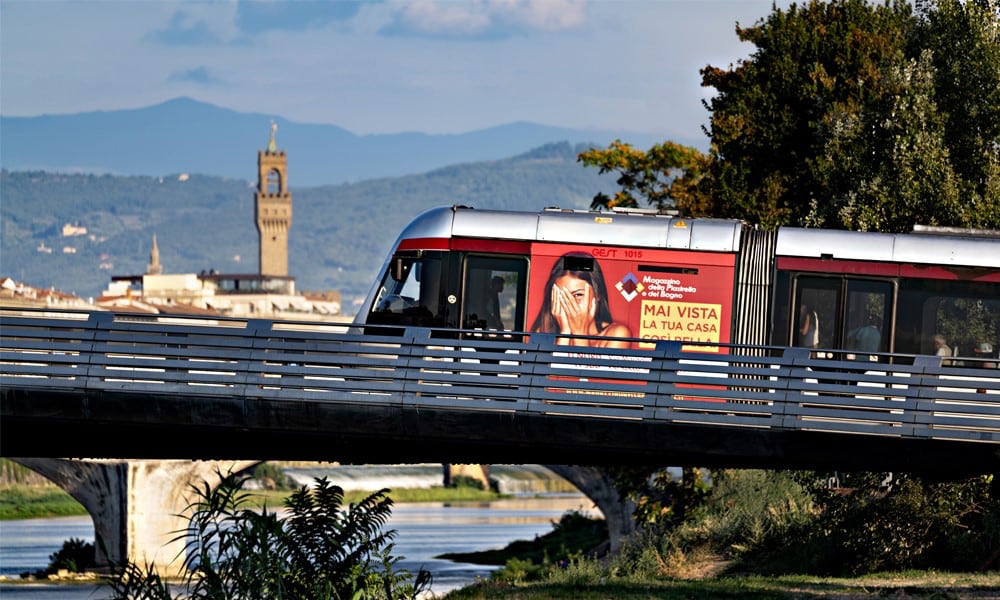"Florence by Tram"
Perspectives beyond the Renaissance
M.A. in Political Science, European Union Policy Studies
Photo credit: Lorenzo Cotrozzi Gruppo Editoriale
By Prof. Caterina Paolucci
The Covid-19 pandemic has changed the world. The way people live, work, move around cities, and travel is going to be revolutionized. Interests have shifted, concerns and approaches have become more diverse and the need for tailored, environmentally sound, and independent experiences is on the rise. The Associazione Via Maggio (AVM), a neighbourhood association with whom JMU in Florence collaborates on community projects, internships and beautification of the Santo Spirito neighbourhood, has just won two grants to start a new project that plans ahead positively for this new reality. The project “Florence by Tram,” envisions sustainable itineraries by tram through modern and contemporary Florence. It is a cultural initiative that links together the ancient city center with its modern neighbourhoods and nearby satellite towns to promote the areas of Florence outside the cradle of the Renaissance.
Trams have been a characteristic of Italian city mobility since the early twentieth century. The first tram line in Italy was actually the one that connected Florence with its hilly sister town Fiesole at the end of the first decade of the 1900s. This means of transport was abandoned in 1958 and replaced by a more flexible public bus system. Then, traffic surged to unprecedented levels after the economic boom of the second half of the twentieth century making the bus system increasingly difficult to manage. Additionally, due to ambitious EU laws against global warming, member states began introducing tight reduction targets for CO2 emissions, meaning each region and city had to report significant improvements every year. Consequently, in the 2000s the city of Florence, which was one of the most polluted among the mid-sized Italian cities, decided to invest again in the means of transport it had abandoned fifty years earlier. Trams are more energy efficient and less polluting than wheel transport, the dedicated lanes make them more punctual, and their capacity is considerably higher.
In 2010, the first new tram line, T1 Leonardo, was inaugurated, connecting the center of Florence to its south-western outskirts until the nearby town of Scandicci. In 2019, the University Hospital of Careggi and the Airport became structurally integrated to the center through the second line, T2 Vespucci. The two lines overlap at the central train station, and then diverge again to reach distinct peripheral areas, which very few non-residents, let alone tourists, ever get a chance to explore. More lines are envisioned in the new strategic urban plan of the city for the next ten years, connecting Florence with its South and North as well.
“Florence by Tram,” is a modular project based on an app. It comprises itineraries that unfold along each of the two current tram lines, starting and ending at each and every stop. The itineraries reach over a hundred points of interest, divided into categories such as parks and sports, museums, entertainment and culture, open air markets and top attractions and show events taking place as well. The passenger, for the cost of a tram ticket, can decide to spend the day discovering a different part of Florence. At each tram stop, the points of interest pop up on the app, indicating the type of attraction, distance from the stop, opening times and current events. The project, curated by the high-end publishing group Gruppo Editoriale, is flexible and easy to integrate with many on-site, as well as remote cultural activities, such as guided tours, artistic performances, and lectures by experts. In the intentions of AVM, this will be replicated on the future tram lines. This will become the reality of the city’s new smart mobility, in accord with the European Green Deal and the Italian government’s ambition to reduce traffic and incentivize green tourism, now that the NextGenerationEU plan has inundated Italy with “green” funds.
“The investment is huge for a small association such as ours”, says Olivia Turchi, President of AVM, “but we are interested in long-lasting projects such as this one, which can become a model for other Italian and European cities as well.” The focus, according to Olivia, will be on modern architecture, of which there are many treasures outside the medieval walls. She mentions the new opera theatre of the Maggio Musicale, and the Stazione Leopolda, an abandoned train station that is now a venue for concerts and art festivals.There are so many diverse attractions; some of my personal favorites include the historical Jewish cemetery of Rifredi and the Villa Fabbricotti gardens.
“Florence by Tram” is an entirely new project for Florence, and possibly for Italy. Although it was thought of and developed before the pandemic, it has anticipated the needs of the post-pandemic citizen and tourist: a new interest in more peripheral areas, with a special focus on the neighbourhoods that have become the place where people not only live, but also telework. Providing independent, niche approaches to where to go and what to do, away from the mass itineraries and standard postcard places. This project pays more attention to the environment and energy efficient means of transport. In general, it is a more independent approach that will be served by a fully responsive and constantly updated app leading you through a series of attractions that cater to a smarter, curious, unconventional traveller.
I hope that students will take full advantage of “Florence by Tram” in the coming years, discovering new and unusual points of view, while finding their own ways to approach the city, and maybe also getting lost here and there, in new places that are different, but worth exploring.
